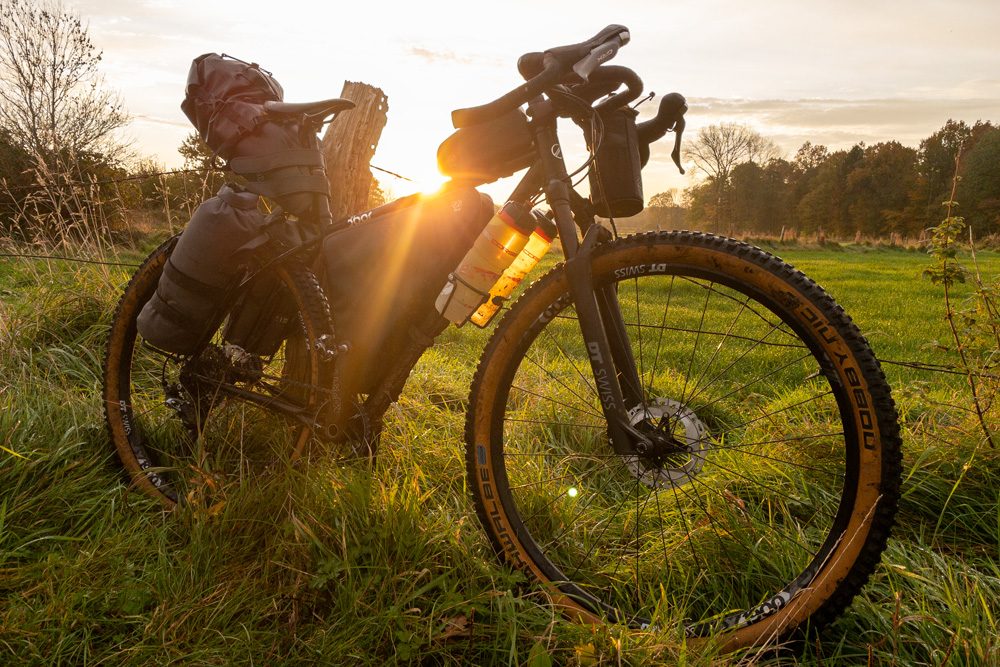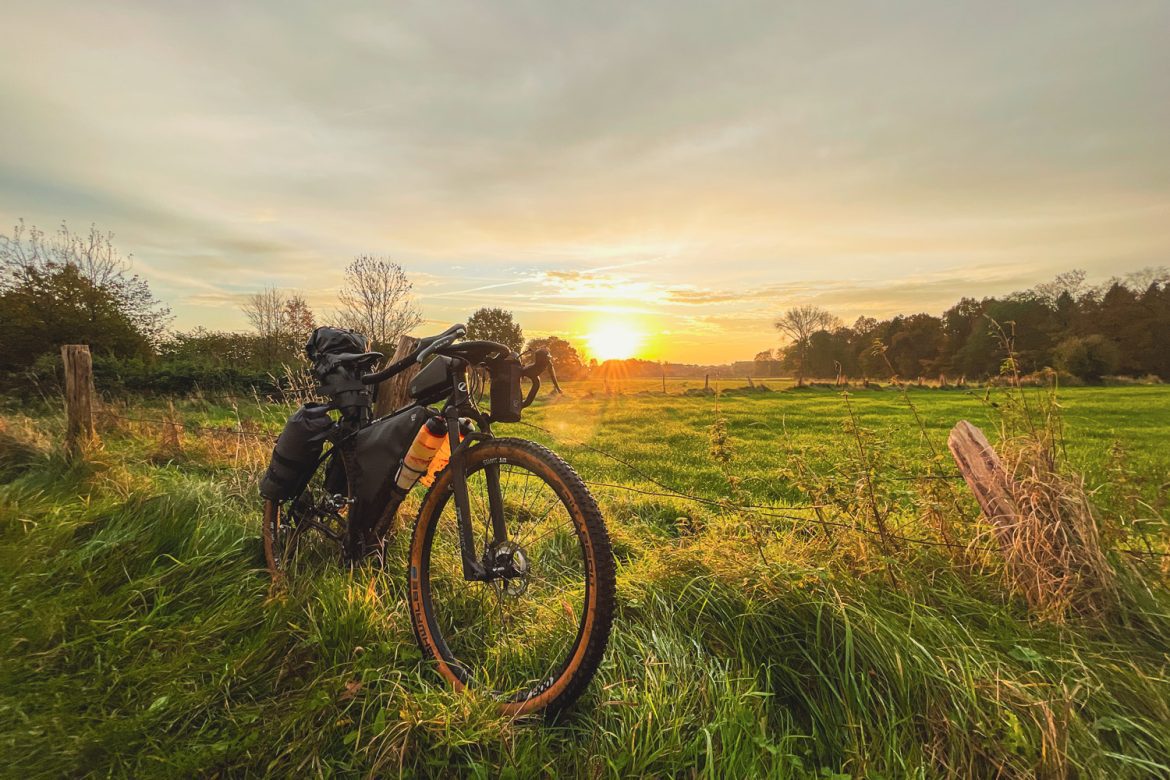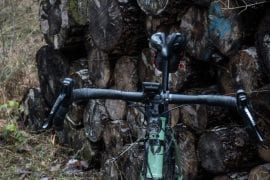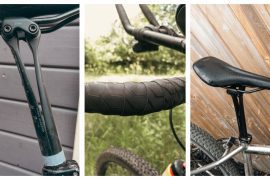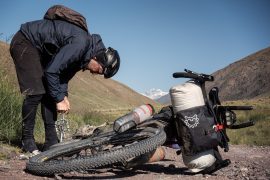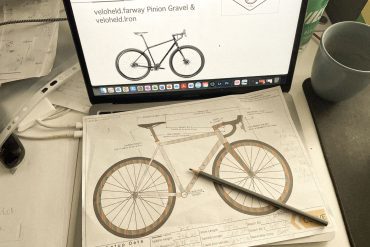A few weeks ago I received an email from 8bar, a bike manufacturer from Berlin, in which a new bike was announced:
If you are once again with your gravel bike on bikepacking tour and no longer want to go on trails, because you prefer to ride with your 40mm tires road, then you should consider whether it is not even time to switch to a real bikepacking bike.
So if a new bike is announced so offensively, then I’m in.
The new bike is the 8bar TFLSBERG, which according to the Berliners…
… is about as much an evolutionary step to the gravel bike as the mountain bike in the 90s to the downhill bike with suspension fork.
If the marketing is allowed to bang so full-bodied in the keys, there must be something behind it. So I asked for a test model, which I then also got very quickly.
The model name TFLSBERG is of course derived from the second highest mountain in Berlin, the Teufelsberg. He towers over the Grunewald and the Havel and is known mainly by the listening facilities of the Americans during the Cold War. Today it is popular with mountain bikers.
The 8bar TFLSBERG in detail
I can understand 8bar quite well, because currently the Gravelbike is hyped up to the wheel for everything, which it is not really.
And that’s where 8bar comes in with their bikepacking MTB trail drop bar bike and joins the ranks of Endurance MTB manufacturers like Salsa with the Fargo, Curve with the GMX+, Trek with the 1120 or Riverside with the Touring 920.
The TFLSBERG 2.0 is our first bikepacking specific bike. It is made for long days in the saddle. That’s why the geometry is relaxed and very comfortable with the large tire clearance. We’ve also included some extra mounts and special seatstays to carry extra load and fluid on your trip.
Geometry
A bike for the long tour, so its geometry is adapted accordingly and turns out more comfortable.
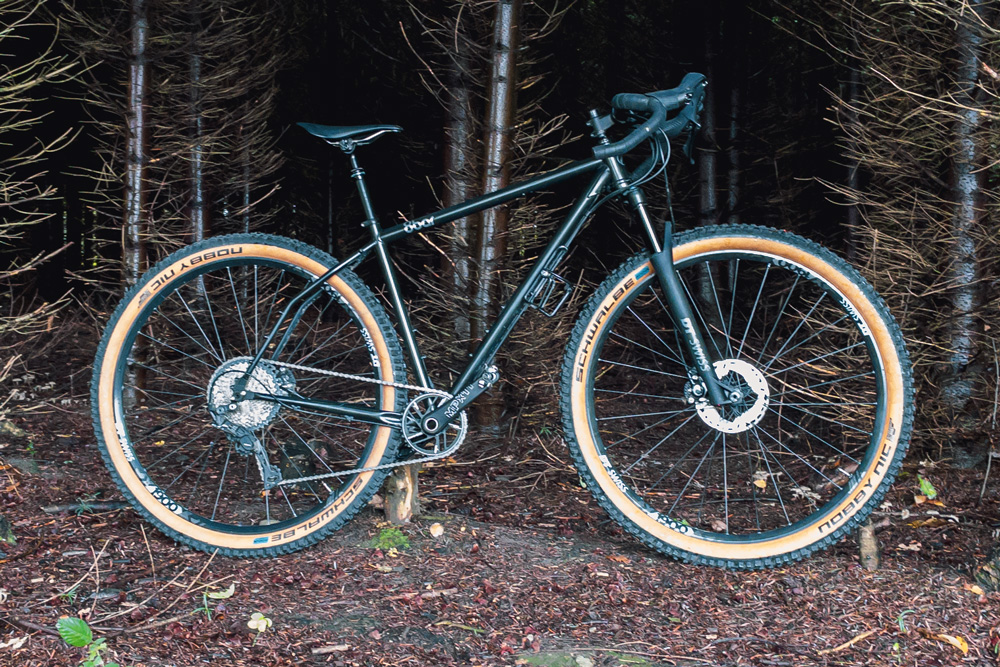
A comparison with the Salsa Fargo shows that the 8bar is less upright than the Fargo. And this is clearly evident in the stack, which is a whopping 30mm larger on the Fargo than the 8bar. And the Fargo’s reach is also 20mm less than the TFLSBERG.
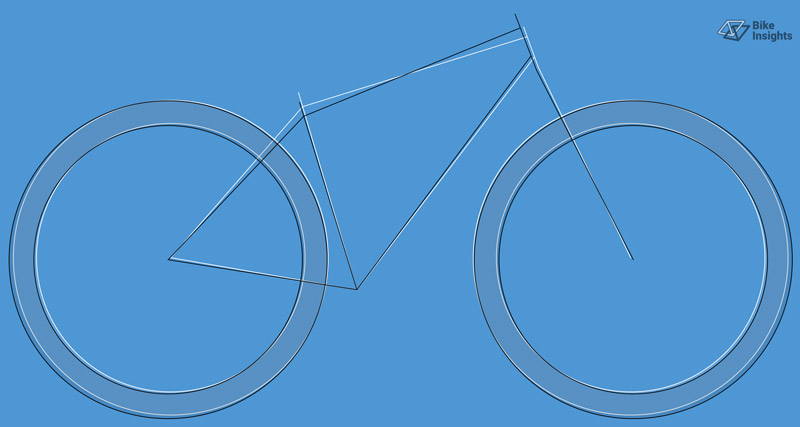
- Lots of stack and little reach mean: The frame is slightly shorter and you sit more upright.
- Little stack and a lot of reach mean: The frame is longer and you sit more stretched/athletic on the bike.
The stack to reach ratio (StR) is 1.58 on the 8bar, making the TFLSBERG a bike that you sit more upright on, which in turn speaks to a bit more comfort on the long haul. The Fargo has a StR ratio of 1.75, which in essence means the Fargo is a long-distance armchair. The chainstay lengths are nearly the same (only 5mm longer on the Fargo) and the bottom bracket is slightly higher on the Fargo than the 8bar.
A comparison with the Riverside Touring 920, also built for the long haul, then shows that in this case the TFLSBERG comes out a bit more upright. The Riverside has 11mm less stack, but 23mm more reach than the 8bar. So it’s a bit sportier than the Berlin bike. However, the French have an 18mm longer chainstay and also the bottom bracket is almost 2cm higher in the Riverside than in the 8bar, which is then relevant in the terrain.
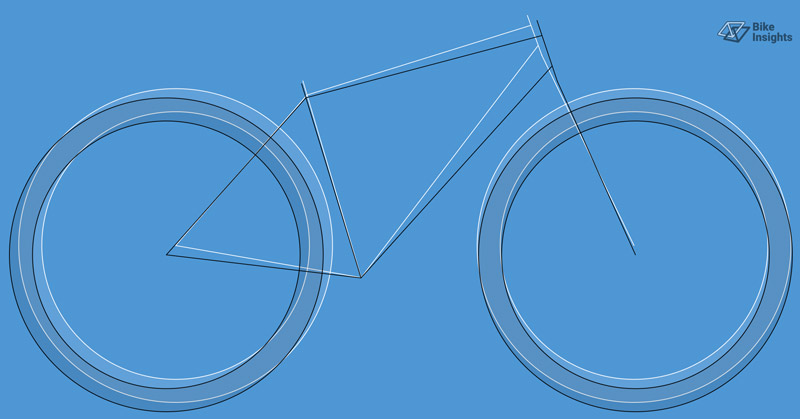
And to provide a little more orientation and comparability: The 8bar has almost the same stack as the Velotraum Finder (-2mm). But the Finder has more Reach (+31mm) and a StR ratio of 1.46. That means: the Finder is more sporty compared to the 8bar, but has a 10mm longer chainstay. The bottom bracket is 7mm higher on the Velotraum than on the 8bar (293mm).
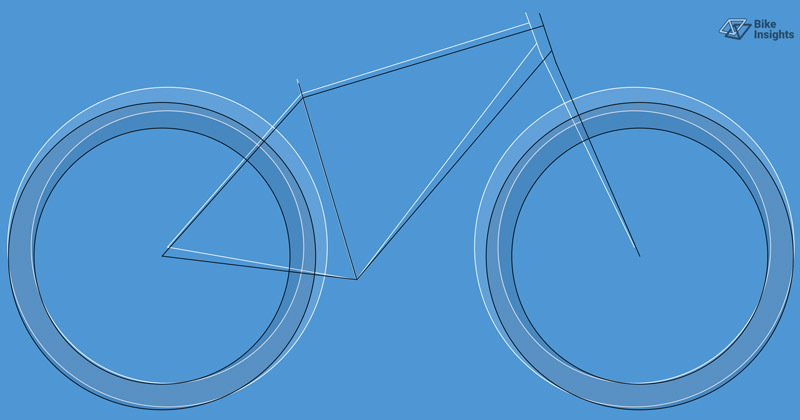
Frame & Fork
The frame is made of steel, more specifically heat-treated, double-butted 8bar CrMo steel. It was designed and engineered in Berlin and is manufactured in Taiwan. The build kit is then assembled in Berlin.
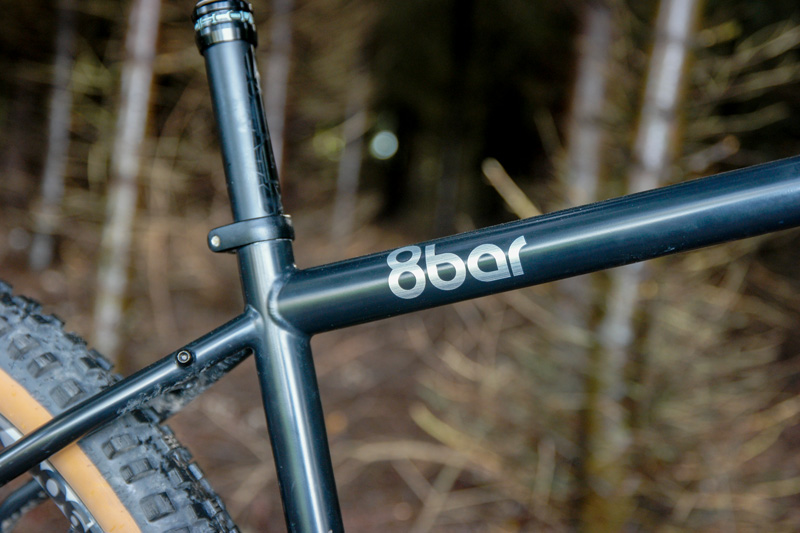
A special feature of the frame – and the reason for my interest – is the well planned arrangement of eyelets. Thus, in addition to the “usual places” there are also eyelets on the down tube top-sided, for example, to attach bottle cages there. I know that from the Curve GMX+ and would also like to have that on my frame.
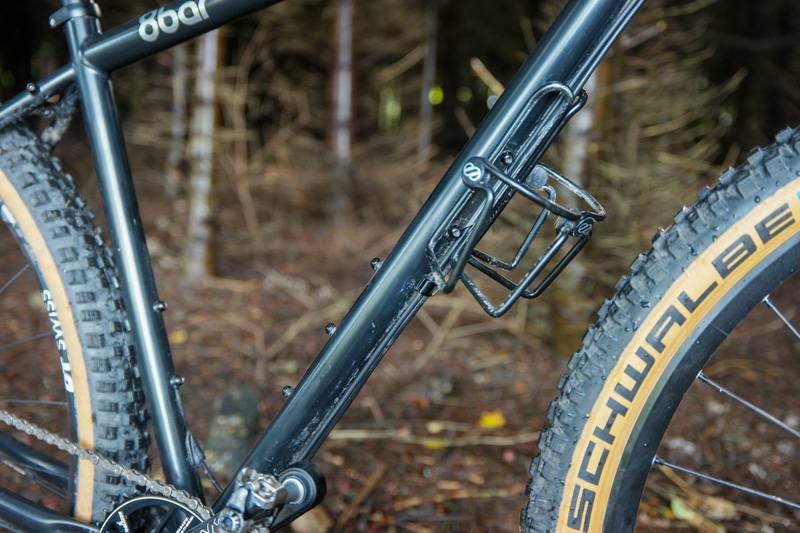
Through this possibility to be able to transport additional bottles, the frame triangle remains free for a bag. Now you might think that the bottles are then in the way of the legs. They are not. However, you should pay attention to what size the bottles have.Depending on the frame size fit there smaller or larger bottles inside.
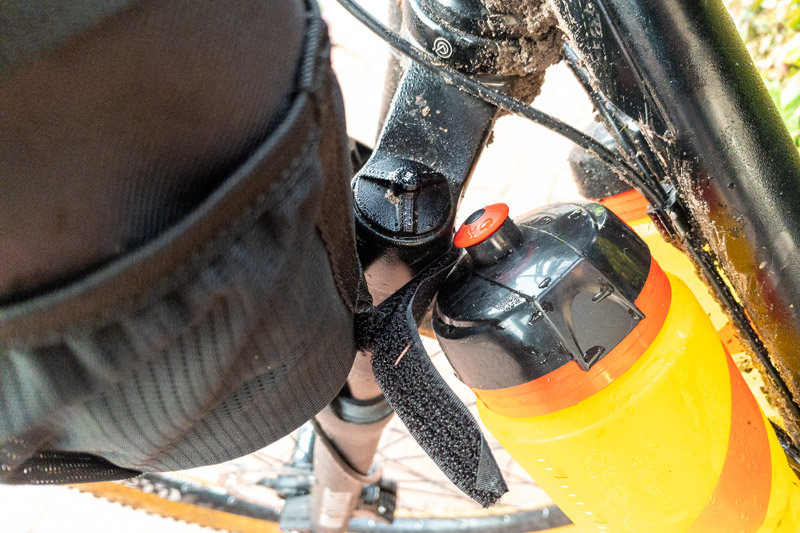
If they are too big, they touch the fork when steering and thus restrict the steering circle, which can be quite painful off-road. I had at frame size M my 950ml bottles inside, which were too large. Up to 600ml but goes well.
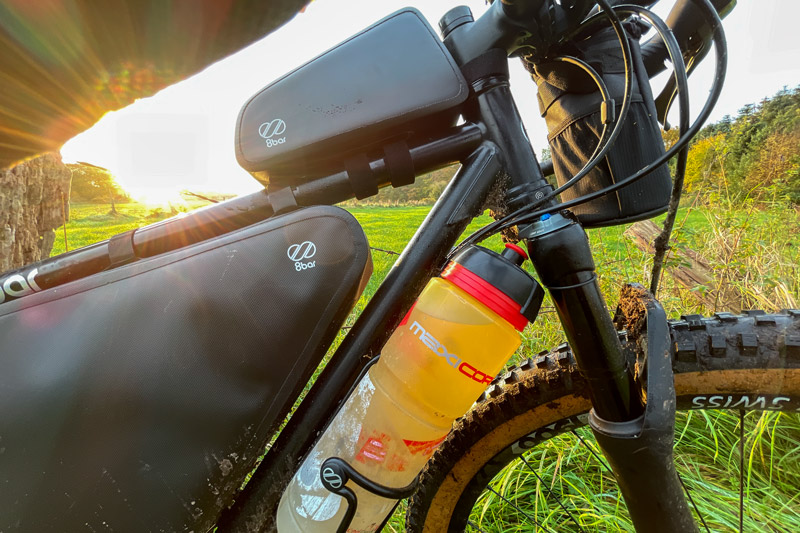
Furthermore, the frame has three eyelets on the seat stays to accommodate carriers or bottle holders. Similar to the Riverside Touring 920, but not as massive. I have attached the supplied 8bar Anything Cages there and then transported 5L panniers with it. More about these cages and their use in practice below.
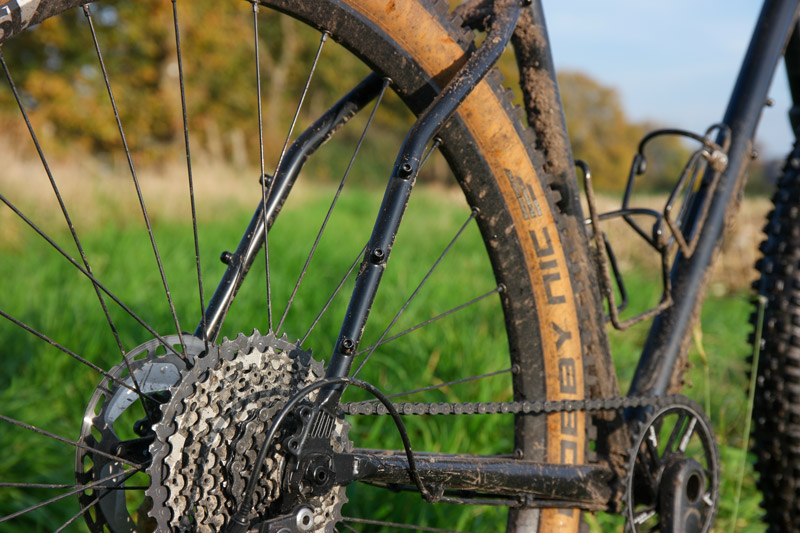
The seat stays are shaped so that the frame should flex even more and provide more riding comfort.
Since comfort plays an important role on longer tours, the seat stays are curved to provide more flex. It also prevents your heel from touching your luggage, which you attach to the seat stays.
Overall, the TFLSBERG frame has enough options to be able to transport your luggage in bikepacking or classic style, or still install racks and mudguards. I would have wished me even eyelets on the top tube for the attachment of cockpit bags. But there is always something …
In addition, the frame is prepared for the stem-internal routing of shift / brake cables and offers a corresponding output for this on the underside of the head tube.
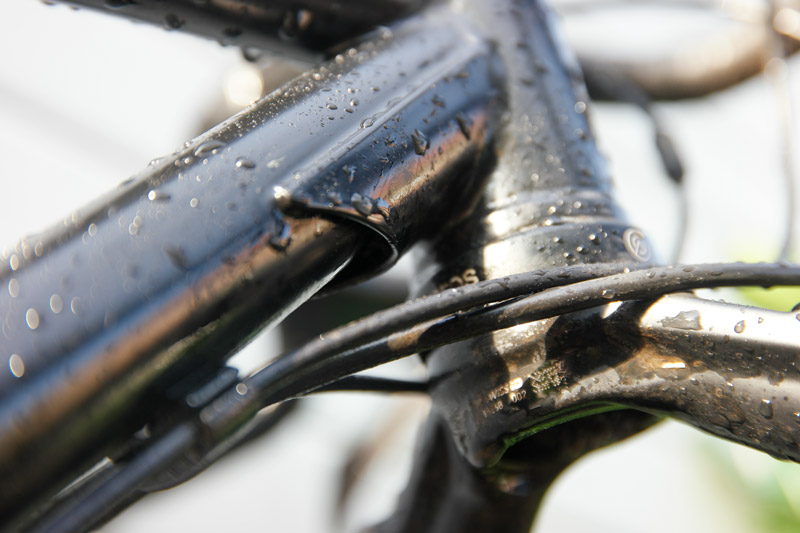
In addition, an opening for the cable for a dropper seatpost is integrated on the seat tube just above the bottom bracket. I had the test bike with suspension fork and dropper seatpost, which is why the cable routing was present here.
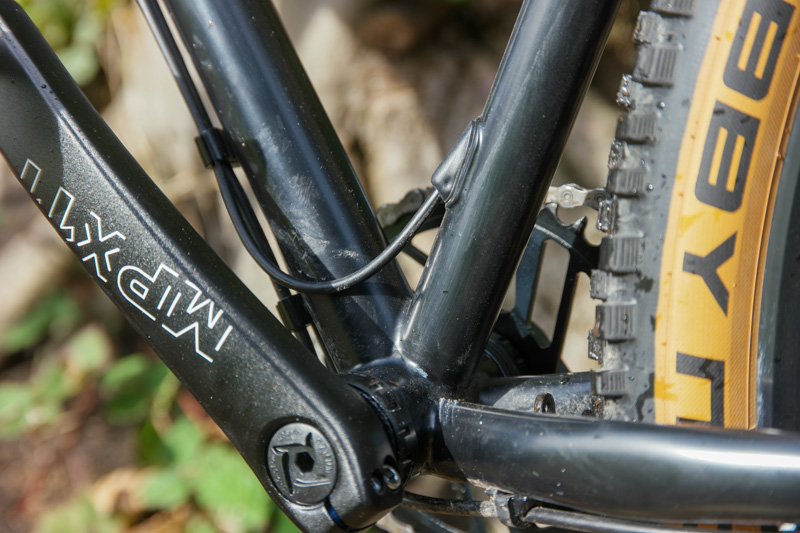
With the fork, you have two options: the 8bar Bikepacking EXT rigid fork made of 6061 aluminum with many eyelets for all kinds of cages and holders, as well as internal cable routing for the hub dynamo. The weight is 900g.
Or the DT-Swiss suspension fork F 232 ONE 29″ with 100mm travel and 51mm offset. This I have chosen for the test bike, also because I wanted to experience how well it works with a dropbar MTB.
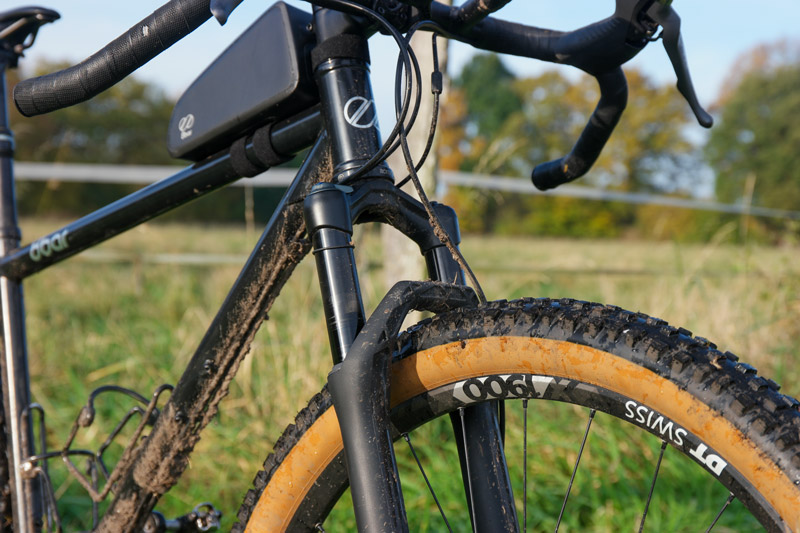
The suspension fork has a remote control. This means that the suspension adjustment is made directly on the right side of the fork above by hand. There is a rotary control with which you can adjust the degree of suspension.
The fork comes from the cross country range, weighs 1,300g and is approved for a maximum system weight of 130kg.
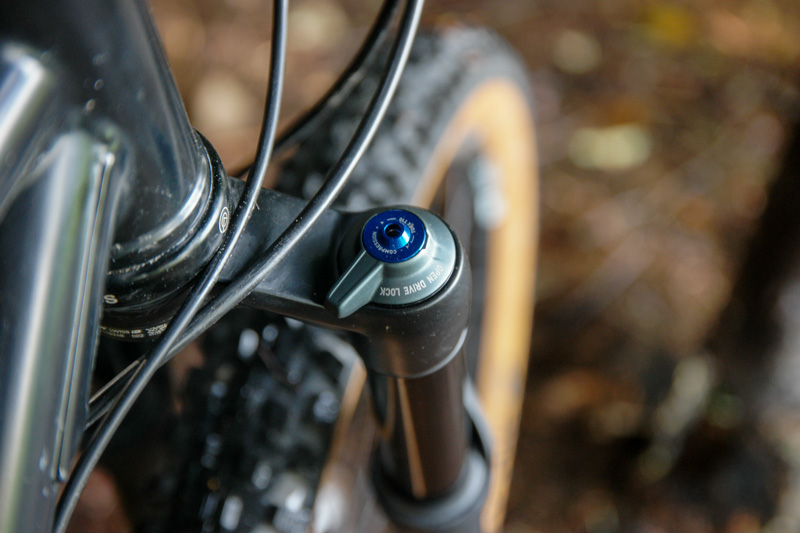
Overall, you can see that someone with practical bikepacking experience was at work designing the frame of the TFLSBERG. The TFLSBERG is an MTB, but then has clear Gravelbike characteristics, such as the brake mount: this is here namely on frame and fork flat mount and not as usual for MTBs post mount. Or the bottom bracket width of 68mm (BSA). This makes the frame but receptive to gravel gear shifting, such as the Shimano GRX.
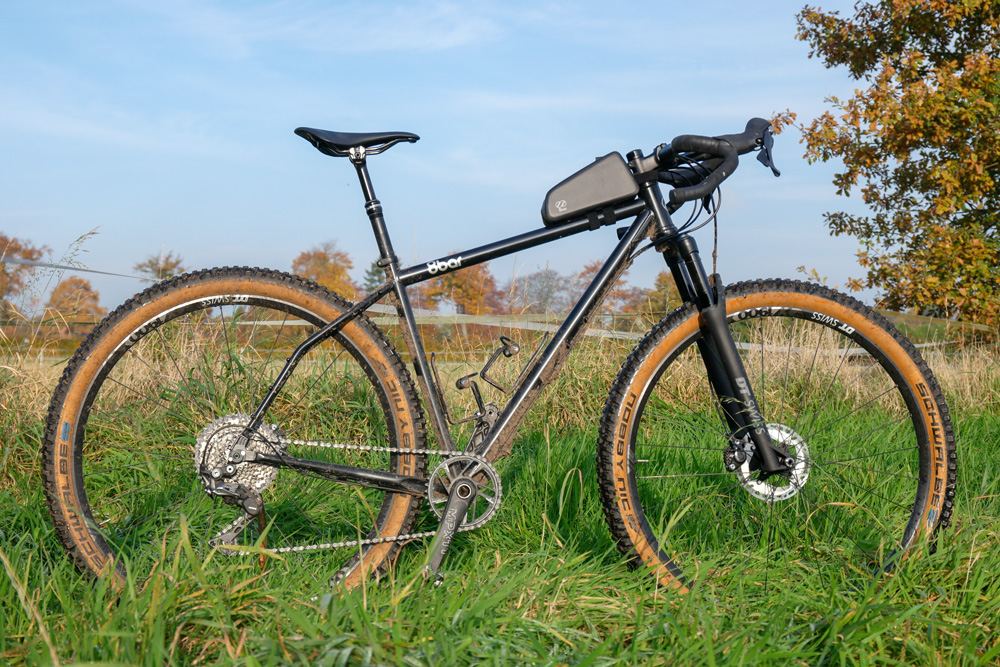
Speaking of the brake mount, the bike only works with 140/160mm brake discs. Larger discs, which you might prefer due to the final weight on a bikepacking tour, unfortunately do not go.
Frame and fork are not made to Boost dimension. A 100×12 thru axle is used in front, a 142x12mm axle in the rear.
The frame weight is 2,200g and the fork (suspension fork) is 1,300g. Overall, therefore, in this combination a total weight of 3.5kg.
The test bike had a weight of 13.25kg incl. Wahoo, suspension fork, bottle cage (weighed ourselves). The system weight (rider+bike+luggage) is 140kg.

Gear & Brakes
The 8bar TFLSBERG is equipped with 1×11 Shimano GRX 600 gears. It shifts reliably and has with rear 11-42 and front 34 a sufficiently good ratio even for somewhat more mountainous passages with luggage off-road. But if it is something more demanding or heavier, I would think about more bandwidth. In the configurator you can then also change accordingly and is offered, for example, a SRAM Mullet variant.
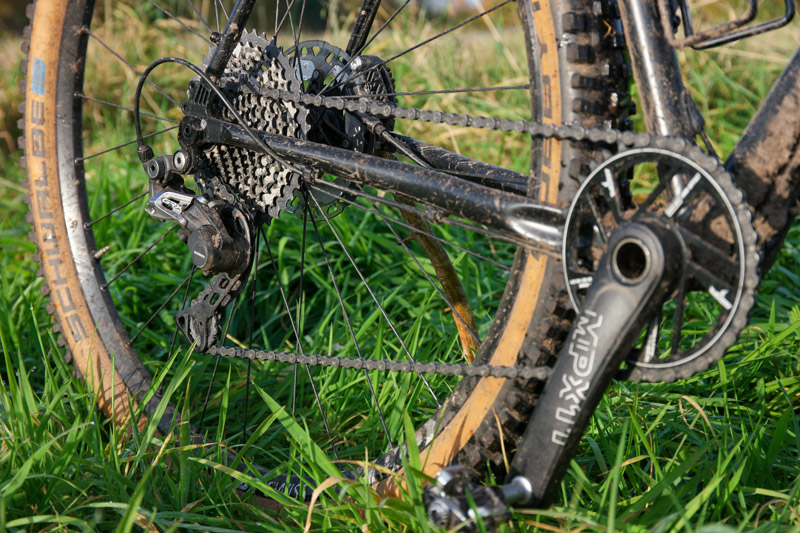
Braking is also with the hydraulic Shimano GRX brakes on 140 or 160mm large discs. Here, too, there are no complaints, but again the note that the 8bar TFLSBERG only allows flat mount brakes.
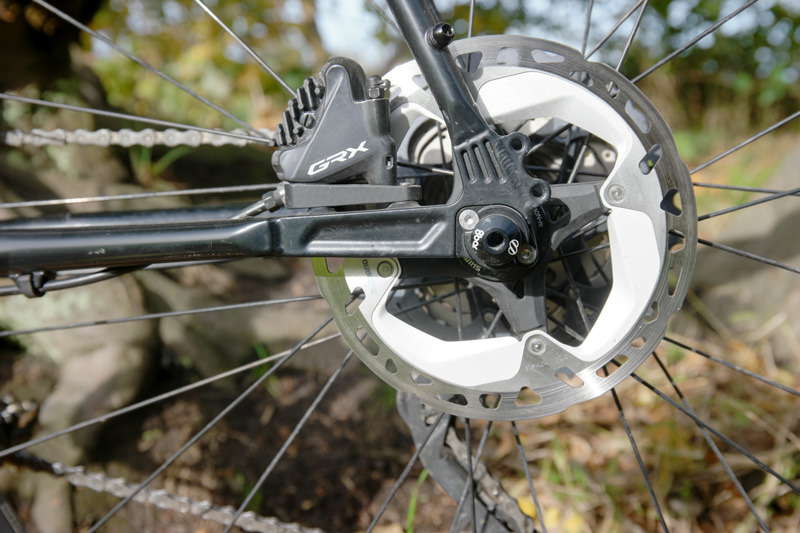
Whether the TFLSBERG can also hub gears such as Rohloff or Kindernay, I asked again. I’ll add that here as soon as I get an info from 8bar. I mean, however, that it is not possible. But let’s wait and see …
UPDATE:
Here is the answer from 8bar to my inquiry:
Kindernay is possible, but Rohloff not as it requires special drop-outs but we can consider them as rider feedback for further development of the bike.
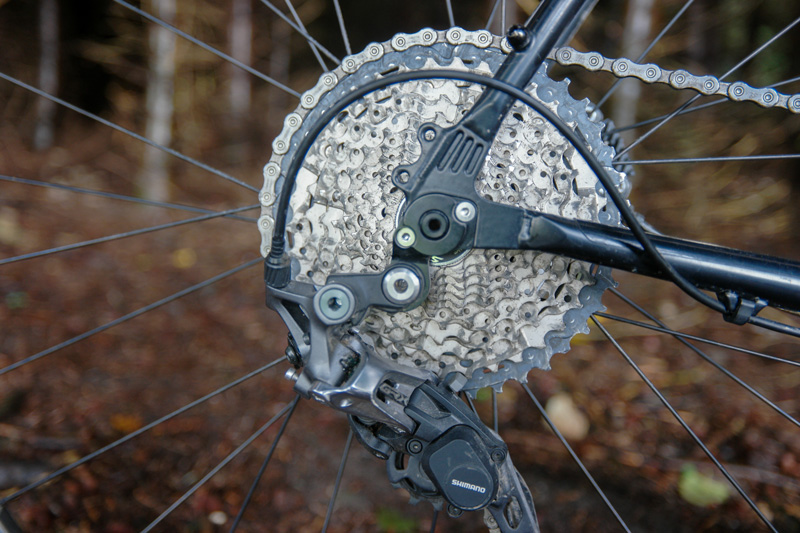
Wheels
The DT-Swiss X 1900 were installed on the test bike. These are solid mid-range cross country rims with a inner width of 25mm. Installed are DT-Swiss 350 hubs. Again, no experiments, but trust in proven and durable parts.

As a maximum tire width is given at 29 inches with 2.25 inches and at 27.5 inches width 2.8 inches. I would have liked a little more at 29 inches, also because the TFLSBERG gives the impression that it would be built for more than that. Finally, 8bar says:
More is better and bigger rolls better. 27.5″ was yesterday. 29″ is the benchmark from now on. If you’ve ever ridden a 40mm “gravel tire” fully loaded over a rooted trail in slow motion, then you know why we designed the TFLSBERG to fit up to 29×2.25″ tires or 27.5×2.8″ tires.
And as if they had already heard me, the test bike came with 2.35 inch wide Schwalbe tires. Even if then the space to the seat tube became tight.
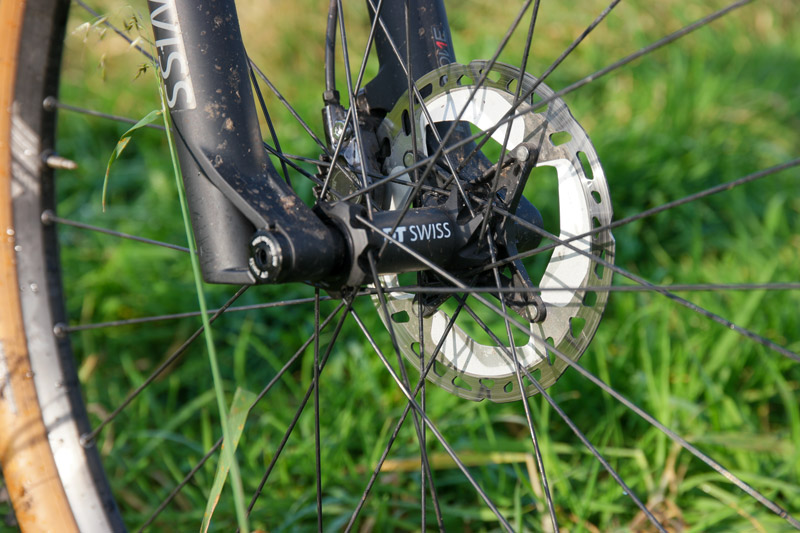
That’s enough under normal conditions, but becomes in mud rides then possibly a problem when too much dirt settles in the gap and blocks the wheel so.
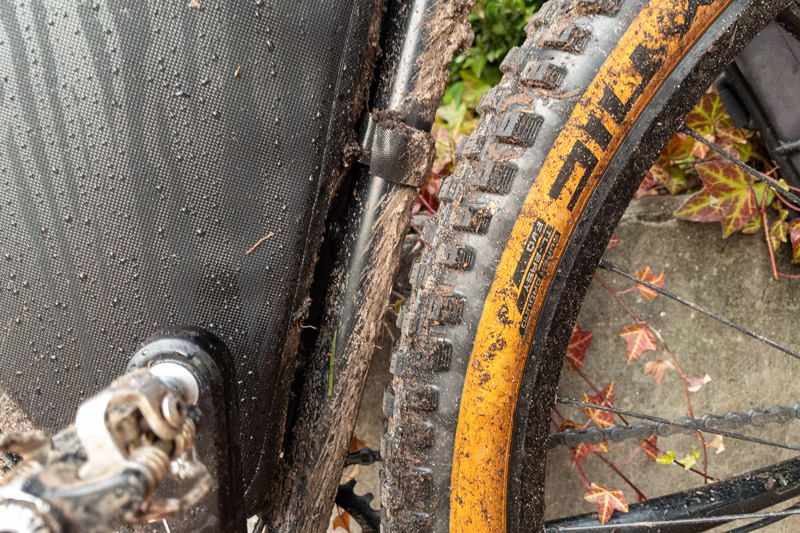
For the tires 8bar has opted for the Schwalbe Nobby Nic. These are certainly good tires and they are considered a solid compromise and all-rounder for cross country rides. For me, they were too cumbersome. In the terrain and especially in mud a good choice. Otherwise, in the forest and on asphalt rather tough. More on this below on the subject of riding experience.

I firmly believe that with other tires, such as the Maxxis Ikon or Ardent, the Vittoria Mezcal or perhaps the Schwalbe G-One Bites, the bike would gain more agility and performance overall. As an alternative, the Schwalbe Thunder Burt are still offered in the configurator.
Handlebar & Seatpost
The handlebar on the 8bar needs a closer look. It’s called the 8bar Drop Bar Bikepacking and has an integrated “mini-aero” bar. It’s interestingly shaped, quite thin and has a flare of 30 degrees, with a drop of 110mm. This is already quite neat and offers a lot of comfort.

Especially the handlebar ends, which pull up again and thus give the hands more control. Thus, it is similar to the handlebars at the Riverside. With a handlebar width of 62cm below and 40cm above, it is quite good off-road and has good control over the wheel.
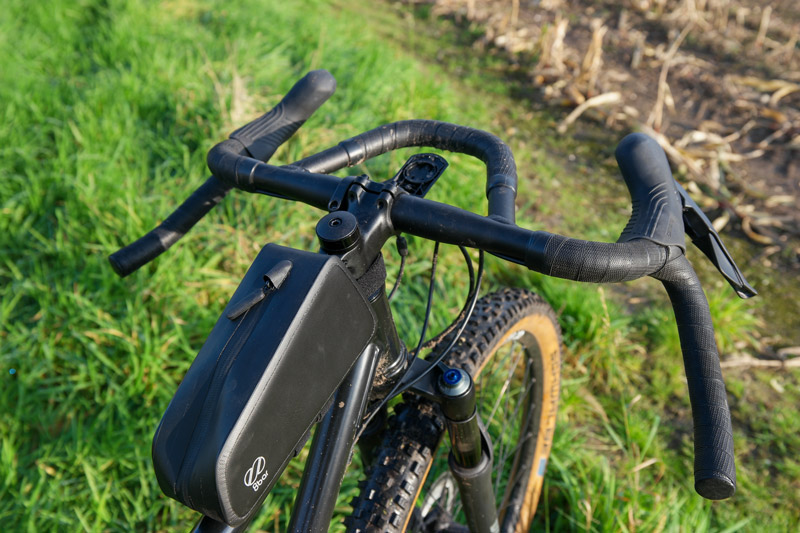
The “Mini Aero” serves according to 8bar as an additional grip position on longer tours and / or for mounting lights or Navi. I found him now not really comfortable or could use it as part of the handlebars, but this was due to the frame in size M, which was too small for me.

Basically, this handlebar is already a good thing, but you must always remember that by the additional loop handlebar wheels or bags are less easy to attach and especially less accessible.
And if you don’t want a drop bar, you can also ride the TFLSBERG with straight handlebars or a normal gravel handlebar.
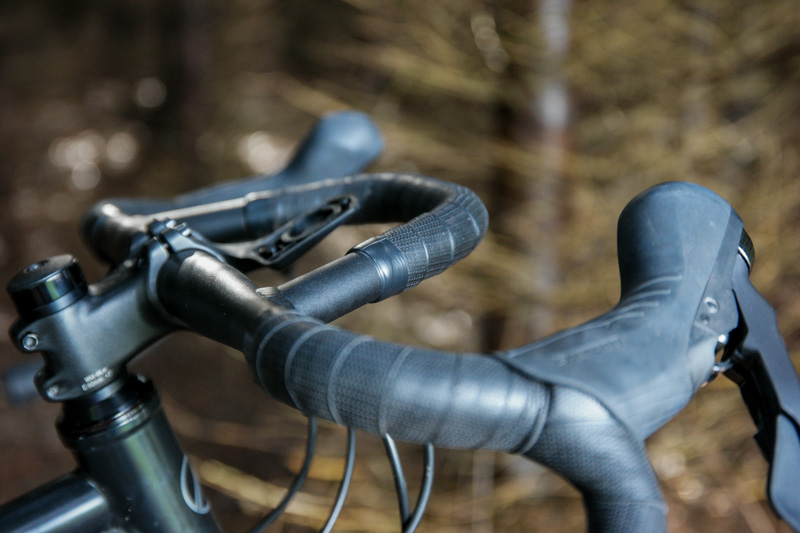
My test bike came with a droppable seatpost. This was controlled by the left brake/shift lever. Such a seatpost makes no sense from my point of view in normal bikepacking, especially since you can then just not attach a saddlebag.
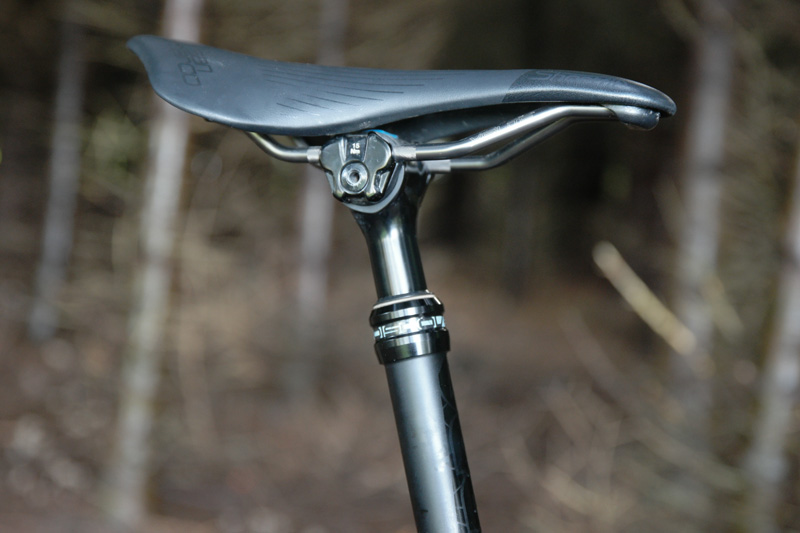
8bar says to it:
With the TFLSBERG we offer flexibility to the customer. You can build it as a long-distance bikepacking bike, but also as a fun bike for the trail. A dropper seatpost is optionally available for this purpose.
However, I would not have seen the TFLSBERG as a fun bike for the trail now.
Basically, the configurator offers many options to put together his TFLSBERG. And who does not find himself here, can also buy the frameset and then go to the self-assembly.
The frameset with aluminum fork costs 800 euros, which is a very fair and attractive price for it.
Riding experience
In practice, the TFLSBERG rides rather comfortably. Partially, I would also say almost cumbersome. 8bar describes it itself as “relaxed” and somehow it fits. On asphalt I am almost stopped with the Schwalbe tires. Off-road, however, the bike awakens and becomes more agile, although by far not as the Fargo or the Riverside or a gravel bike. In return, it offers a lot of directional stability and safety and, thanks to the suspension fork, sufficient comfort and control when it got a little rougher.
I was also able to measure this coziness of the 8bar: Compared to my Fargo, I was between 3-5 km/h slower with the 8bar. What I could clearly feel was the flexing of the frame. However, this also costs a lot of power. So I would almost say that of the usual 8,000 watts I usually pedal, 2,000 watts went into the frame.
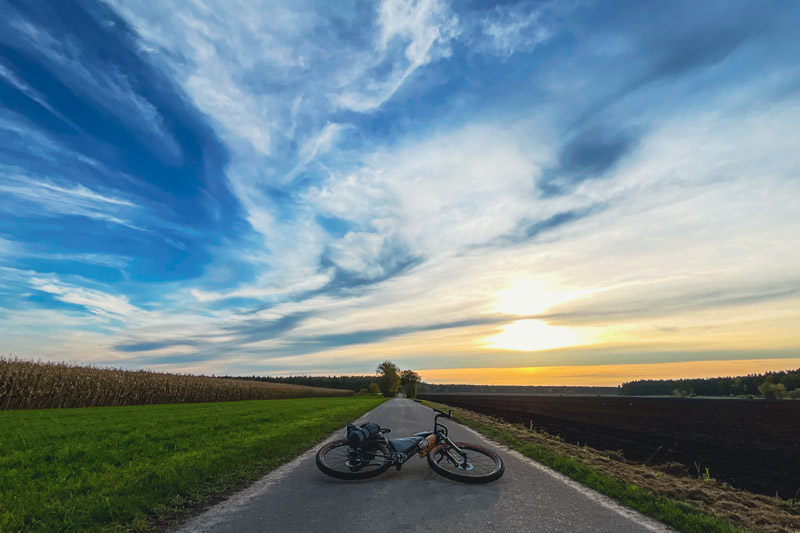
I would therefore not consider it as a bike with which you should participate in more sporty bikepacking trips, but rather as a bike, built for the bikepacking trip, where it is about the experience and less the result.
So a bike when it may be a little more: More luggage, more time, perhaps thereby also more experience and a little more weight.
The suspension fork has given me a lot of fun and the operation is also well possible while riding. On normal gravel roads, I turned off the suspension. If it got a bit more bumpy, the suspension fork provided more riding comfort.
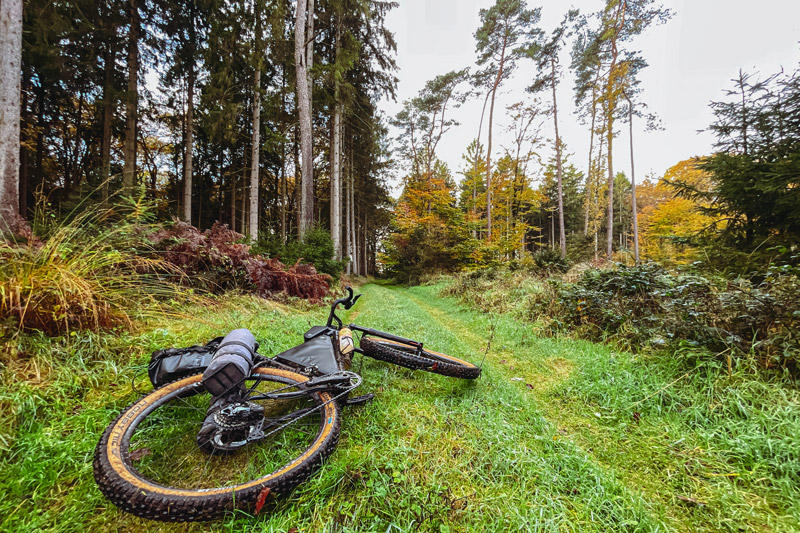
However, I couldn’t find much difference in the suspension of the DT-Swiss with 100mm compared to the Redshift stem on the Salsa. Both delivered subjectively felt almost the same performance on the same track.
I rode the bike in size M and would probably have been better with my 1.84m height and an inner leg length of 80cm with the size L.
Update: Practical experience with the TFLSBERG
Kai aka Rad Bengelz bought the TFLSBERG frameset with rigid fork and built it himself. In the first step with 29 inch Vittoria Barzo XC tires, 1-speed SRAM Rival, front 38t, rear 11-46:
One thing in advance: I wanted something different, nothing similar to what I already have.Steel was the absolute “must”, many eyelets and versatility in terms of tire choice were the focus of the decision. Of course my budget as well. So, the decision was conscious. I did not want a racer, I wanted a tractor .
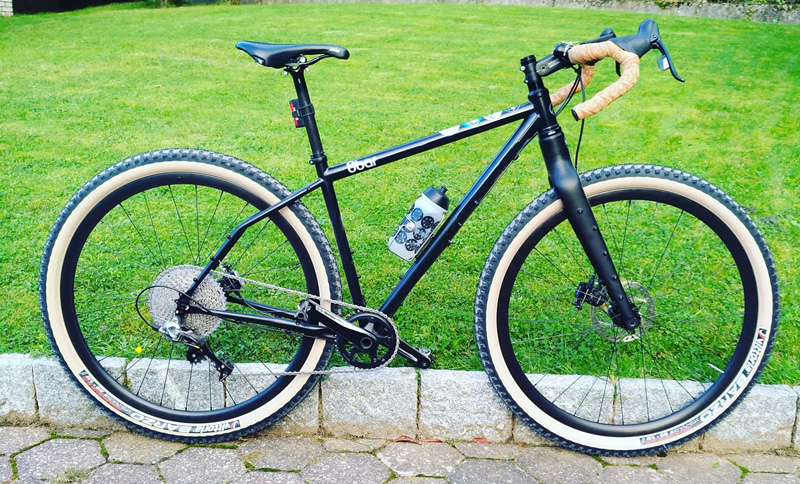
Riding experience with this combination:
…well, with currently 12.5 kg of course bit chubby.Extremely stable straight running, you have to literally force the bike to change direction. Steel was the absolute “must”, many eyelets and versatility in terms of tire choice were the focus of the decision. Of course my budget as well. So, the decision was conscious. I did not want a racer, I wanted a tractor .
Riding experience with this combination:
…well, with currently 12.5 kg of course bit chubby.Extremely stable straight running, you have to literally force the bike to change direction. It rolls away with a stubborn calm about pretty much everything in the way. As I said, speeding was not the approach of the purchase. It rolls away with a stubborn calm about pretty much everything in the way. As I said, going fast was not the approach of the purchase.
You have to want it, I wanted it, and it’s exactly what I’m missing.
So far, so comfortable. Then Kai has converted to a 27.5 inch wheelset….
So without further ado, the 29er Vittoria “Barzo” in 2.25, were replaced by 27.5er Panaracer Gravelking Sk in 53mm on DT Swiss HG1800.
… and experienced a surprise:
The bike suddenly goes fast around the corners, much more agile and contrary to the performance description a small trail predator, always necessary bike control assumed. Fun without end, comfort abundant and suitable for “riding fast”.
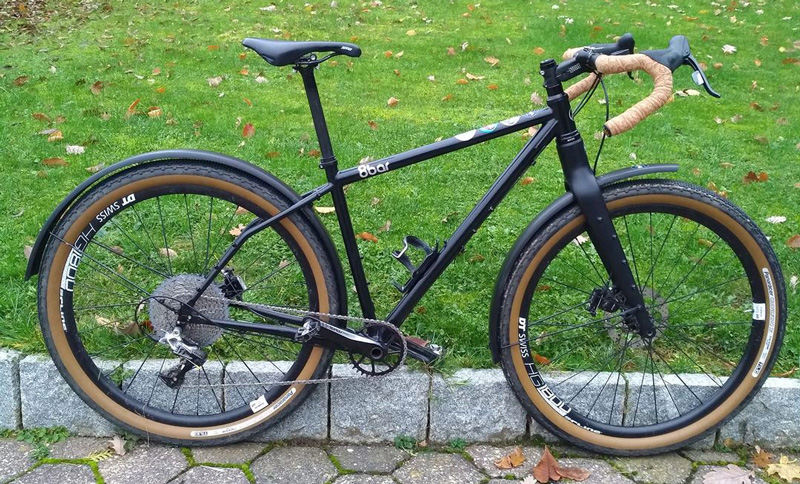
Classification in Martin’s Allroad Bike Categorization
As you know I have developed an Allroad Bike categorization, in which I classify all the bikes I test and thus create a little more clarity.
This is not easy, also because the variety of types, applications, categorizations and trend designations make it almost impossible to structure this once. Nevertheless, I have tried it once. I have formed three categories under the umbrella term all-road bike, but of course they overlap and thus also have commonalities:

- Performance & Race: Some of the bikes come from the racing bike / crosser area and / or are inspired by there. Especially road cyclists who switch to gravel find pleasure in these very sporty bikes, which are primarily intended for competitive use.
- Leisure & Everyday: Here I see the bikes that combine the sporty and the relaxed, and with which you can go almost anywhere without thinking much about it. Yes, here we’re talking mainly about the classic gravel bike as a primo offering to those who don’t want to worry about the surface anymore, but just want to ride.
- Travel & Adventure: Yes, even the daily commute to work can be adventure, but in this category I see all bikes that are suitable for almost all terrains, whose roots lie more in MTB and which make off-road, bikepacking and bike travel in all varieties possible.
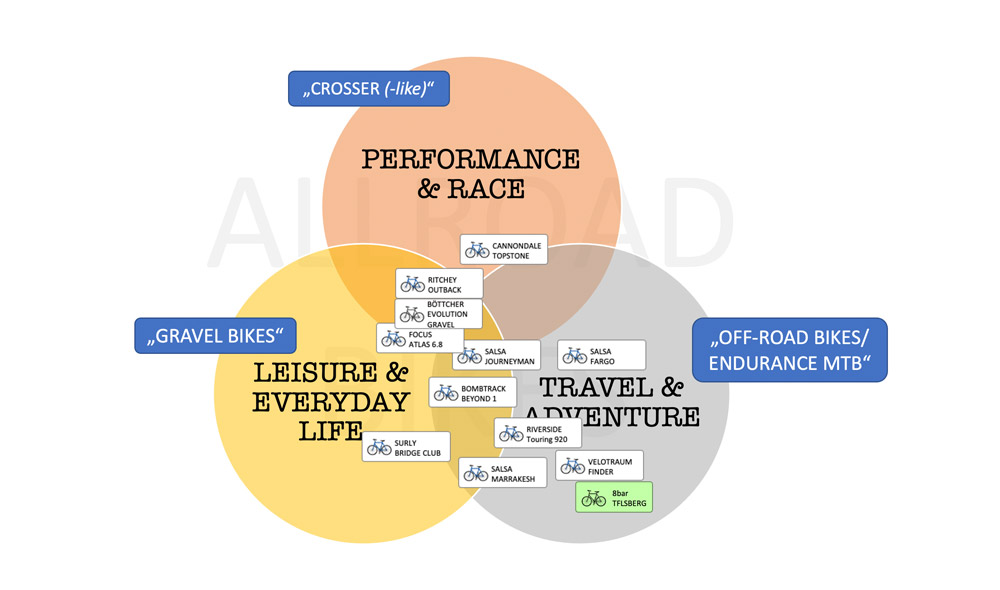
In my view, the 8bar TFLSBERG is clearly in the Travel & Adventure category and ranks there alongside bikes like the Riverside Touring 920, Salsa Fargo or Velotraum Finder.
Conclusion 8bar TFLSBERG
The TFLSBERG is a bike for the bikepacking tour without record attempts and has smart details for it. It rides comfortably or good-naturedly, is not quite as agile, but conveys a lot of safety and directional stability off-road. The rather “soft” and flexing steel frame costs some power, but also takes you everywhere.
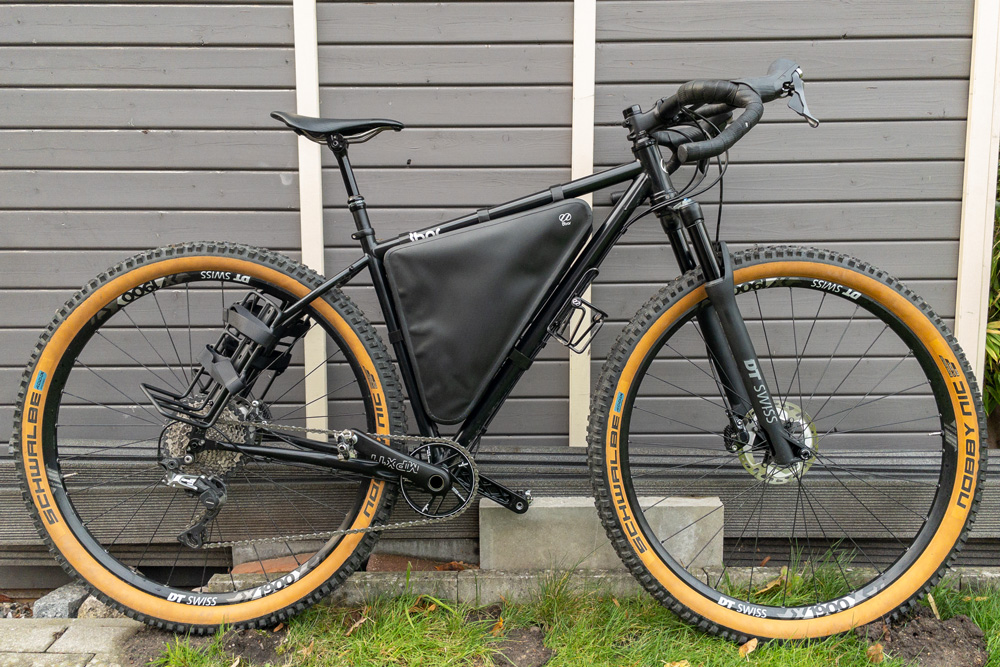
With the Schwalbe tires, the 8bar TFLSBERG feels particularly comfortable on muddy forest trails. On asphalt or gravel it rolled rather slowly.
But is it the better bikepacking bike compared to the gravel bike, as 8bar puts it? I wouldn’t make that distancing, as they are simply different requirements. It’s like comparing a touring bike to a sporty trekking bike. With both you can do the same, just differently well.
For the longer tour with a little more luggage and through trail-heavy terrain, the TFLSBERG is certainly the better choice, also because the frame simply offers more possibilities and is better designed for many days and hours on the bike. For this, the 8bar is not as agile and fast as a gravel bike.
And with a price around 2,400 euros (currently, in the GRX600 configuration), the 8bar TFLSBERG is well worth a look for anyone just looking for a new bike for leisurely bikepacking.
The 8bar Bikepacking bags
With the test bike I also got a selection of the new 8bar Bikepacking bags and the Anything Cage. And then tried them out accordingly on a short tour with Overnighter.
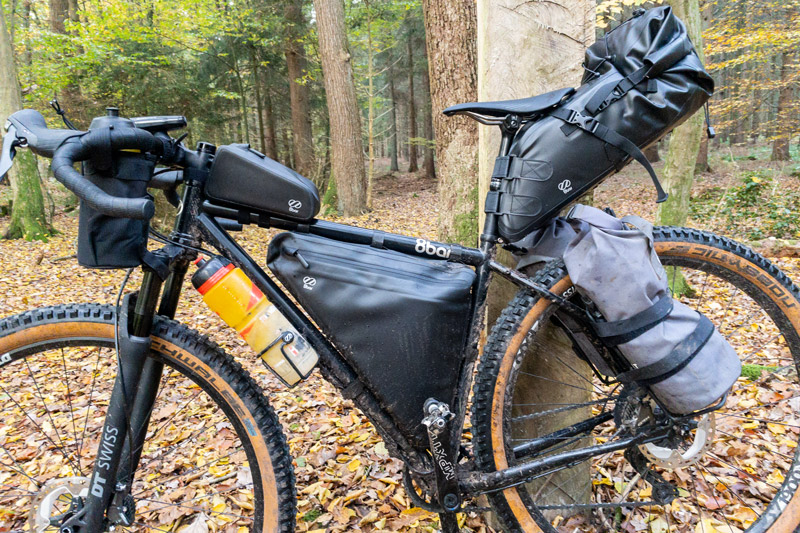
The bags are designed by 8bar and produced in China. The material of the Top Tube Bag, Saddle Bag and Frame Bag is waterproof. And therefore also heavy. The material of the Handlebar Roll and Snack Bag is water repellent.
Quite interesting: Normally bikepacking bags come with ready-made straps, with which they are then attached to the bike. The 8bar bags are supplied with a roll of Velcro tape, from which you then cut the individual Velcro straps to fit the frame. This is quite practical and has worked well in practice. The Velcro tape also does not dissolve at the cut edge and holds very well.
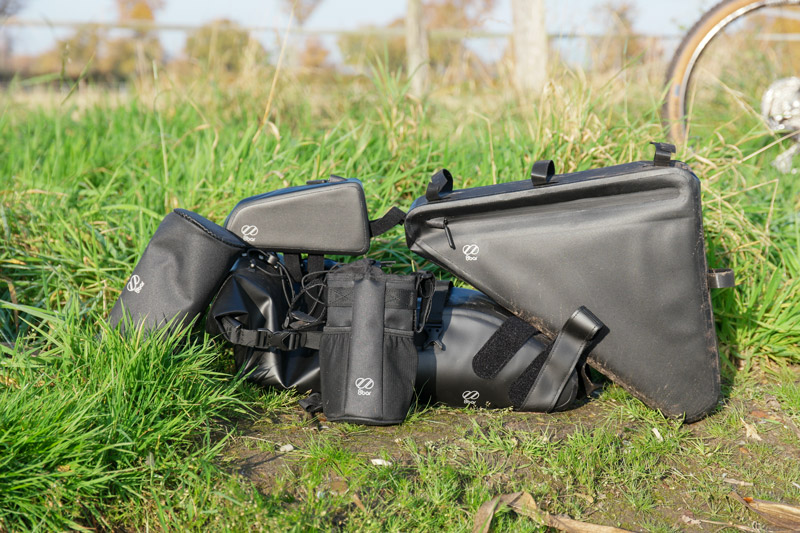
I have used all bags except the Handlebar Roll. The Handlebar Roll I have not used, because it does not really make sense with the Bikepacking handlebars on the TFLSBERG and then also would not have been easily accessible.
The 8bar Top Tube Bag
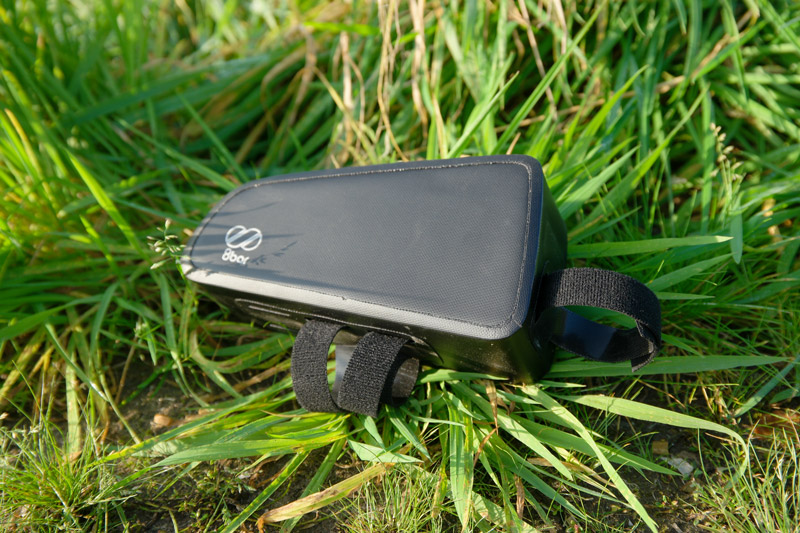
The top tube bag of the Berliner is dimensionally stable and has a waterproof zipper, which, however, can be easily operated.
The bag is attached with one or two straps at the bottom and one at the front of the headset / stem. Once fixed it holds well and does not slip during the ride. The space is with 1.2 L big enough for a little more stuff. I have transported snacks and a power battery in front.
- Dimensions: 20 x 6 x 10cm (L/W/H)
- Volume: 1,2L
- Weight: 118g (100g reweighed)
- Price: 30 Euro
I liked this bag, also because for the price you get a waterproof and sufficiently voluminous bag that also looks good in plain black.
The 8bar Frame Bag Big
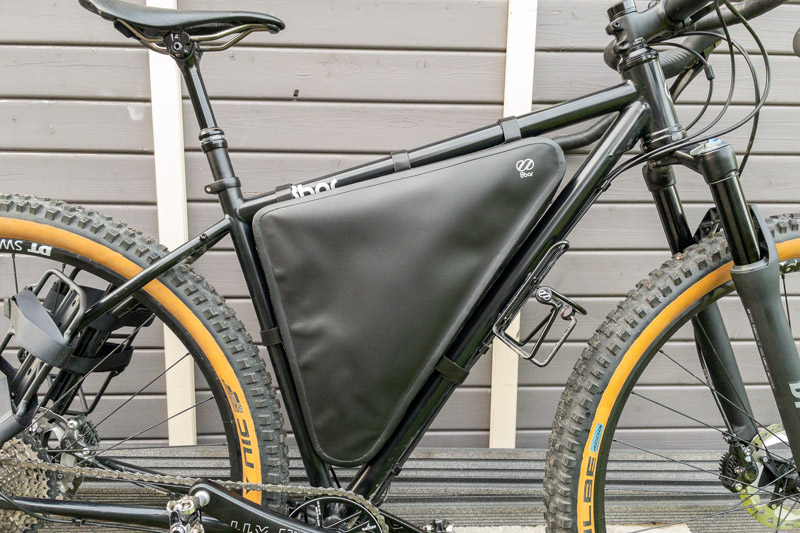
On the TFLSBERG in size M, this frame bag filled the frame triangle very well.
The attachment is done by Velcro straps over various points on the sides of the bag. For this you have enough tabs to meet different frames.
The bag is very dimensionally stable and makes a robust impression. Again, a waterproof nylon fabric (truck tarpaulin) is used, along with welded seams and a waterproof zipper on the left side.
Inside, the bag is very spacious and takes a lot of stuff without building up too wide. That it has “only” 5L volume, one would almost not believe. For this it is with 400g but also not particularly light.
- Dimensions: 39.5 x 9 x 35cm (L/W/H)
- Volume: 5L
- Weight: 350g (400g reweighed)
- Price: 60 Euro
I also liked this frame bag very much. Simple, discreet, waterproof, no frills. At a price of 60 euros a good tip for all who are looking for a reasonable frame bag, do not pay attention to weight and do not want to spend so much money.
The 8bar Saddle Bag
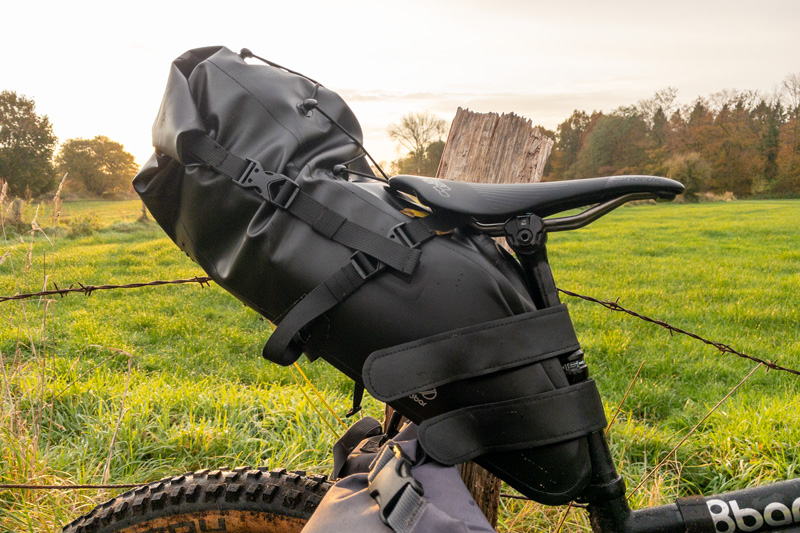
It looks big and very sturdy, which it is. According to 8bar, it should only hold 13L, but in practice this is already a lot and seemed to me partly more than my 16L bag. According to 8bar, the bag can be compressed from 13L to 6L. Manufactured it is also made of waterproof nylon fabric and therefore somewhat heavier.
The built-in valve is good, through which the air can escape when compressing. This should always be standard for saddlebags nowadays. At the top is an elastic band, through which more equipment can be fixed on the bag.
The saddlebag is rolled and then closed on the right and left with click closures. However, these are made so that they do not work crosswise. The closures only fit together on their respective sides. That’s not ideal, because sometimes the cross-over closure is a good option to keep the packed bag from sinking and provide more dimensional stability.
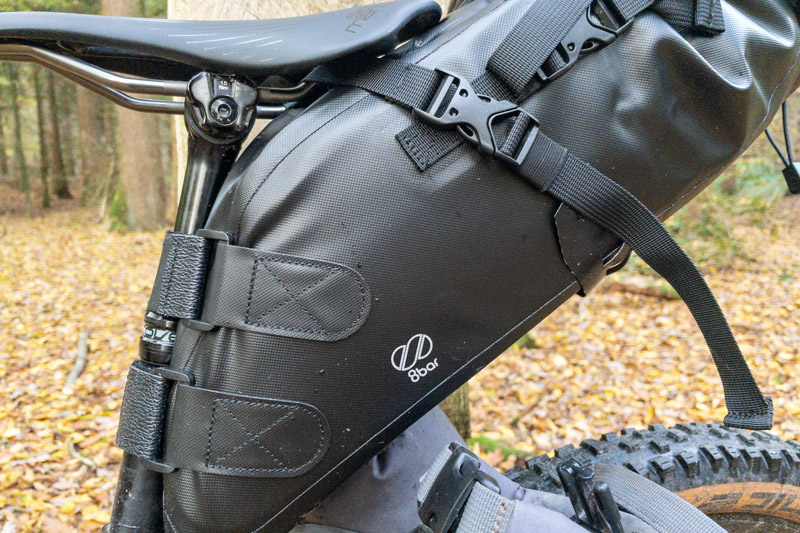
The Saddle Bag is fixed with two straps, which are passed through the saddle frame. And two wide straps for the seatpost. So far so common. However, the straps at the bottom of the bag have a lot of play and the counterparts on top of the bag are somehow not optimally positioned. This leads to the fact that the bag is somewhat more difficult to assemble in a packed state and – more importantly – can not be properly tightened and fixed. The bag therefore wobbled extremely back and forth and thus also impaired riding, especially off-road. No matter how I tried, the bag could not be fixed properly. Presumably, the straps went through the movement while riding again and again, which then resulted in even more wobble.
- Dimensions: 72 x 35 x 16cm (L/W/H)
- Volume: 6-13L
- Weight: 700g (700g reweighed)
- Price: 80 Euro
A properly packed and fixed saddle bag does not wiggle. At least I’ve never had a saddle bag that wiggled back and forth like a tail like the 8bar Saddle Bag. I have not been able to get it tight and I am sure it is due to the design and attachment of the straps. This may just be me, but there is no way I can recommend this bag for a serious bikepacking trip. The is no fun and its movement also affects the riding.Now of course I would be interested to know if other riders of this bag have observed this behavior?
Update:
8bar has informed me that the bag comes with a strap, which should prevent the wobble. I will therefore test the bag again with this strap and then once again report.
The 8bar Snack Bag
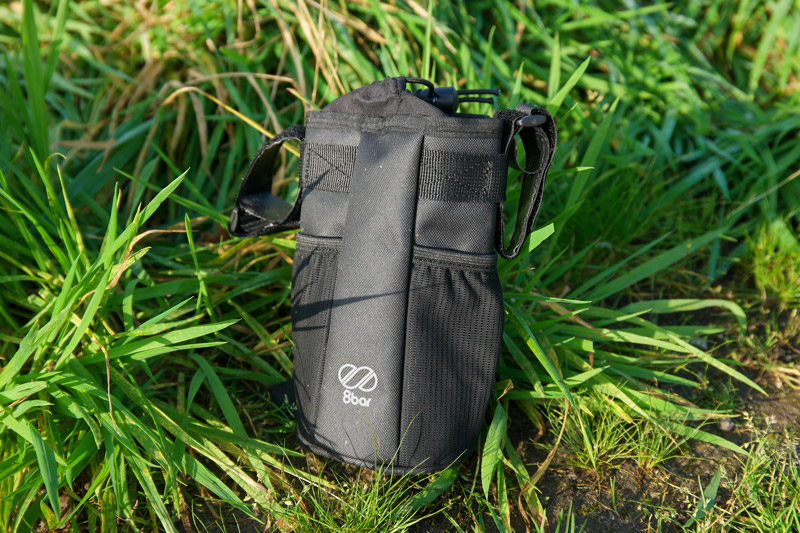
The Snack Bag is a small well thought out bag, which is attached to the handlebars and in which then either a bottle or food or other stuff is transported, which should be quickly available. In addition, the Snack Bag has small nets / pockets on the outside, which can hold gels or bars or small stuff. The material is made of waterproof nylon, but that does not matter, because the opening at the top can not be closed completely anyway.
The snack bag is easy to attach. This is ensured by two Velcro straps for handlebars and stem. In addition, the bag is then secured below still with a strap on the fork or frame.
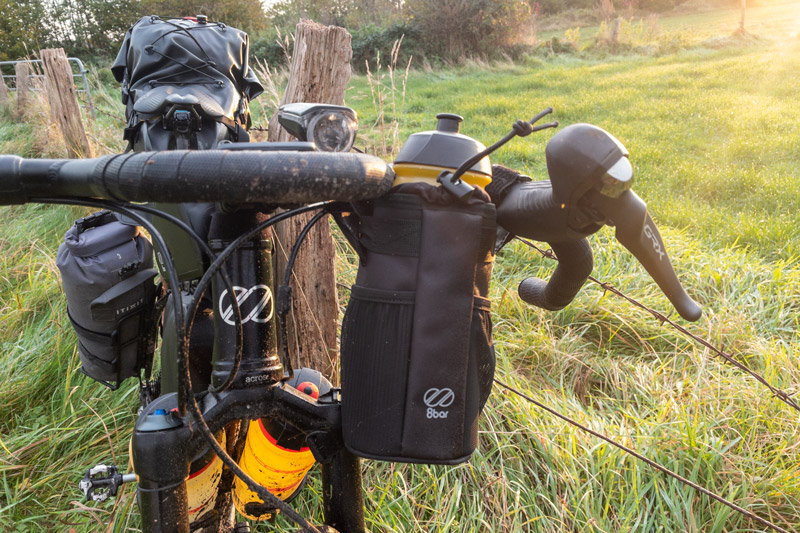
At the top, an elastic band ensures that nothing falls out. The elastic band can be easily operated even while riding. The snack bag has space for a 600ml bottle. Do not be surprised: At the bottom is a hole through which water or crumbs can disappear. Very practical, especially since the Snack Bag also usually remains on the wheel.
- Dimensions: 22 x 9cm (H/W)
- Weight: 95g (100g reweighed)
- Price: 20 Euro
In my opinion, the 8bar Snack Bag is very good and absolutely suitable for bikepacking. It has decent space, can be fastened well and also versatile use through its side pockets. Weight is ok and usual in the market, the price very good for this quality.
The 8bar Anything Cages
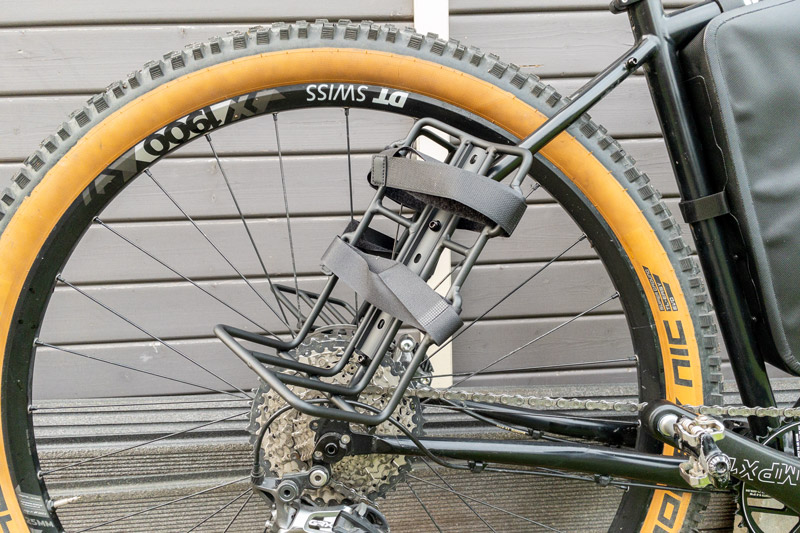
The TFLSBERG has eyelets on the saddle stays, which can accommodate such a cage, to which then a pannier or a larger water bottle are attached.
The principle also exists on other bikes, such as the Riverside Touring 920 or the Curve GMX+. The mounting of the Anything Cages is very simple. But unfortunately the holes are not standardized with the eyelets of the TFLSBERG. This means that the Anything Cage is mounted above the lower eyelet with then only 2 instead of 3 screws and then rests on the lower eyelet.
The 8bar Anything Cage comes with permanently mounted straps/tapes with Velcro firmly attached to the end. These straps are quite long, which should be noted, one rides without a pack and only with the cage. Then you have to be very careful that the straps do not get into the spokes and remain well fixed to the cage.
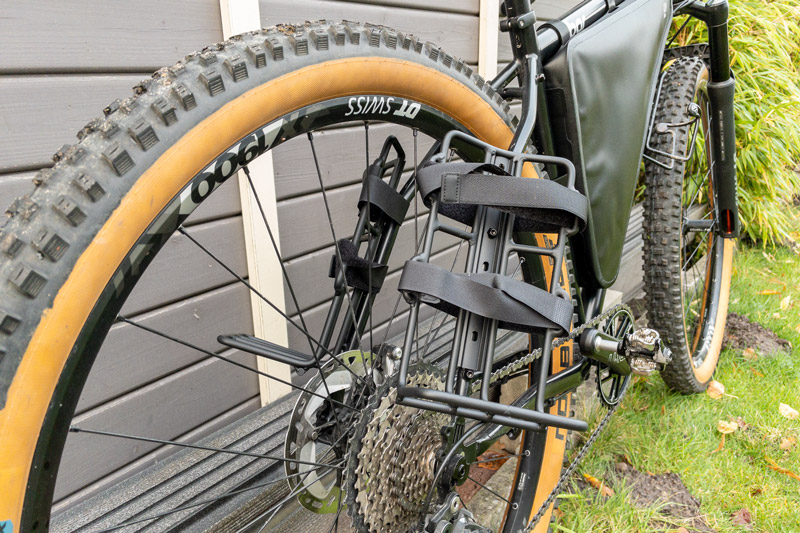
The 8bar cages build very wide, also appear very bulky. When mounting, they therefore also protrude a little further in the direction of the wheel. But that fits already, even if at the TFLSBERG the eyelets could be gladly a few millimeters outwardly inclined.
In the cages I rode 5l panniers. So you then already come above very close to the tires. But in practice, that works quite well. In the frame size M I only had heel contact with the cages / packsacks from time to time. But that should not be an issue with frame size L.

To fix the panniers to the cages, you use the straps. These are always fixed on the left, which is ok for the cage on the left side (seen from behind), because the end of the bands protrudes away from the wheel. On the right side is then not so good, because the end protrudes into the wheel purely and rattles from time to time in the spokes, also because the pack is never always completely full and so just also tape remains.
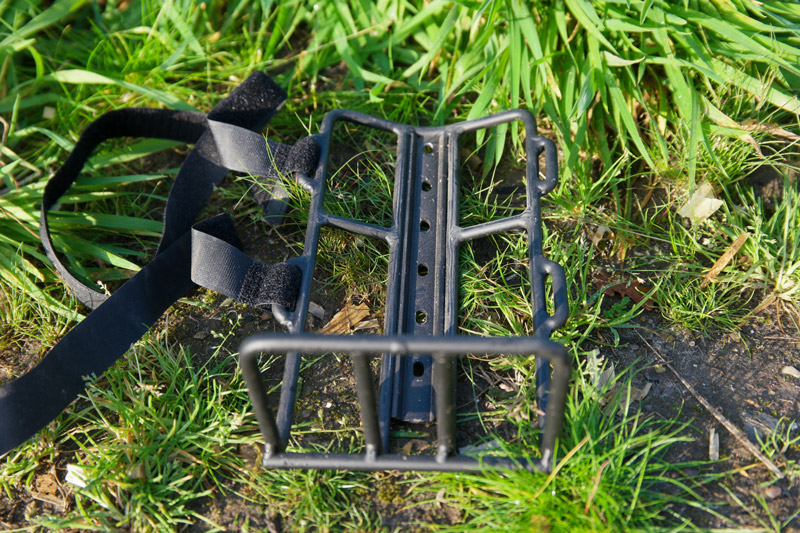
Furthermore, the area with the Velcro on the tape is too short. Thus it is not quite easy to fix the tape and the pack sack. Something more or even continuous Velcro would possibly remedy this.
- Dimensions: 24 x 13 x 10cm (H/W/D)
- Load diameter max: 20cm
- Weight: 280g (250g reweighed)
- Price: 30 Euro
The 8bar Anything Cages are ok. But for me they are too wide and bulky. And I am bothered by the firm fixation of the straps. I’m more a fan of the Blackburn Anything Cage, which is narrower and where the straps can be attached as needed.
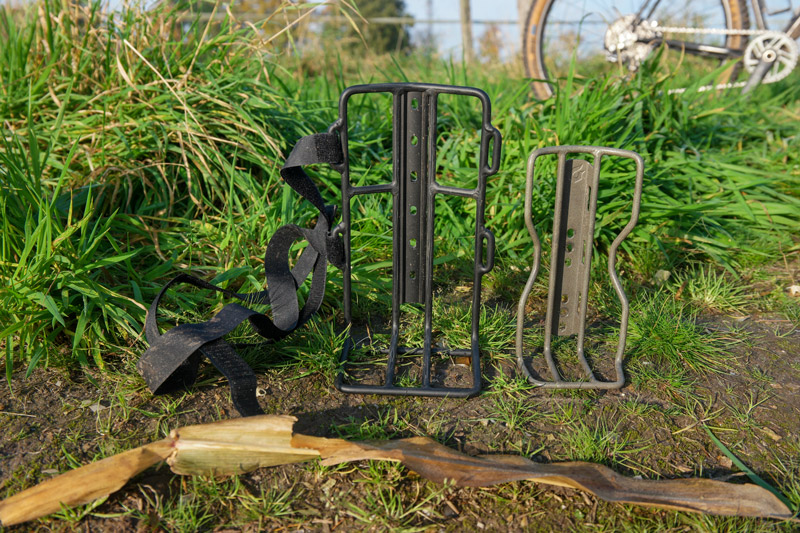
It too holds my 5L pack bags with no problem and has held them reliably in Kenya and Tanzania. 8bar also offers Dry Bags for the Anything Cages. They contain 5L and cost 20 euros.
Conclusion 8bar Bikepacking bags
Overall – with the exception of the saddle bag – I liked the 8bar Bikepacking bags. They are good bags for starting the adventure of gravel touring and bikepacking, which are especially waterproof and offer decent space. And the price is also very attractive.
